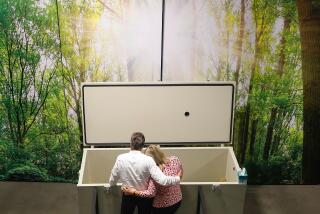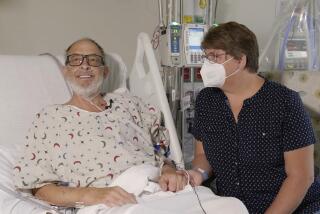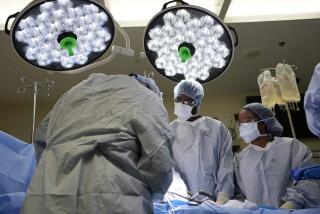Researchers ‘Reanimate’ Dead Animals’ Hearts
In a series of experiments in lambs and goats that seem straight out of science fiction, surgeons at Loma Linda University Medical Center have “reanimated” hearts that have sat lifeless within dead animals for as long as 45 minutes and successfully transplanted them into other animals.
The researchers say that these preliminary findings, if confirmed and deemed ethically and legally acceptable for tests in humans, could dramatically expand the supply of human hearts for organ transplants. Because of an extreme shortage of organs, more than a quarter of the 2,400 Americans awaiting heart transplants are likely to die before a heart becomes available.
With a combination of drugs and other manipulations, the scientists have reanimated and transplanted hearts more than 20 times, said Dr. Steven R. Gundry, a heart surgeon and leader of the research team.
“We really hope that if this continues to work, there can be a real use of donors that are being absolutely wasted now,” Gundry said in an interview. “There is a lot of disbelief among other surgeons but at the same time a lot of excitement.”
Now, hearts for transplantation are removed from individuals who are pronounced brain dead, while they are maintained on a respirator and their hearts continue to beat. The continued circulation of blood prevents the heart from deteriorating. The typical organ donor is an otherwise healthy individual who dies in a motor vehicle accident, of head trauma, a gunshot or stabbing, or sudden bleeding into the brain.
But in the current system of organ procurement, many potential donors who die in these ways are never identified. In other instances, family members decline to authorize organ donation.
Although the demand for heart and other transplants is growing, the number of organs obtained from cadavers has leveled off. In 1991, there were 2,127 heart transplants in the United States, about the same number as in 1990, according to the United Network for Organ Sharing in Richmond, Va.
The new approach raises the possibility of, with consent, procuring hearts from otherwise healthy individuals who die because their hearts stop beating. Such individuals might have bled to death, despite resuscitation in hospital emergency rooms. Such hearts have not been considered usable.
For some, the experiments may conjure up fears of a technological future in which the private passage of death is increasingly manipulated for the benefit of the living. For others, the developments may be seen as a sign of medical progress, leading perhaps to better treatments for many heart surgery patients, not only those who receive transplants.
Indeed, death might need to be redefined before “reanimated” human hearts could be transplanted. Legal definitions of death make reference to an “irreversible” cessation of heart function and do not take into consideration the possibility of restarting the heart and transplanting it to another person.
In addition, many experts see a fundamental conflict of interest between emergency room physicians who try to save lives and transplant surgeons who try to obtain the heart or other organs for use in another patient.
“It is kind of like the movie ‘Coma,’ where they are (harvesting) organs and killing people off in operating rooms,” Gundry said, making reference to the worst scenario of skeptics. “Suppose a trauma victim comes into an emergency room. Do you go all out or do you say: ‘Heck if this guy doesn’t make it, I will still have a bunch of good organs.’ It could get into sinister science fiction and raise problems for a skeptical public.”
Gundry said he has named the technique “reanimation,” a term often associated in the public mind with scientific fantasy, because it seemed to offer the best description of the research.
In an interview, Gundry said heart surgeons have believed for many years that the heart muscle suffers irreversible damage at normal temperature if it is deprived of blood and oxygen for 15 minutes or more. His research team and others, however, have found that the damage is less than was feared.
In fact, much of the damage appears to be preventable by the use of the “right cocktail” of medicines to preserve the heart and to restore blood flow. Gundry’s cocktail includes drugs to dissolve clots in the heart arteries, to prevent the heart arteries from going into spasm, and to prevent a massive and irreversible contraction of the heart that can be caused by high calcium concentrations. Blood flow is restored gradually over a one-hour period.
“We are using a bunch of soup,” Gundry said. “We do not know what the most important ingredient is, but every time we take one ingredient out, it doesn’t seem to work as well.”
He added: “If you just take a dead heart out and hook it up to somebody else and open blood flow, it won’t work. It will stay dead.”
In the first report of the ongoing research, being published in the May issue of the Annals of Thoracic Surgery, Gundry and his colleagues described the successful “reanimation” and transplant of four “dead” hearts from juvenile lambs.
According to the report, the hearts were harvested after the animals, who had been anesthetized, were allowed to bleed to death in a manner that simulated a failed resuscitation attempt in an emergency room.
After a 30-minute period, which simulated the time to needed to secure organ donation permission from a next of kin, the heart was filled with a cold preservative solution, removed from the body, and then stored for about 90 minutes in iced saltwater. The heart was then transplanted into another lamb. All four hearts resumed normal contractions.
Similar short-term results have also been obtained with lamb hearts that have stopped beating because of a lack of oxygen and with goat hearts. In some experiments, the animals have been dead for 45 minutes. Within the last few weeks, Gundry and his colleagues have started transplant experiments in goats to determine how long such hearts can continue to function normally.
Gundry said he does not know how long is “too long” before irreversible cell death occurs regardless of the technique of restoring blood flow to the heart.
It would probably be necessary to change the legal definition of death in the United States for “reanimated” hearts to be used in humans. Under California law, death is defined as “irreversible cessation of circulatory or respiratory functions, or irreversible cessation of all functions of the entire brain, including the brain stem.” Most states have a similar definition.
“It opens up a real Pandora’s box,” Gundry said. “The heart is dead in that person. It will stay dead in that person as long as we don’t do anything about it. But the heart is not necessarily dead in another person.”
“This poses real problems for the definition of death,” said Arthur Caplan, a medical ethicist at the University of Minnesota in Minneapolis. “The presumption is that irreversibility is complete and total loss of function without the ability to restore (the heartbeat). Reanimation would raise obvious questions and doubts about the irreversibility criteria.”
Reanimating hearts or other human organs could also raise serious quandaries for emergency room personnel. They are trained to do everything possible to save patients’ lives, not to treat their patients as potential organ donors.
The physicians trying to save the patient and those trying to take the organs “cannot be the same people,” said Dr. J. Donald Hill, chief of cardiac surgery at California-Pacific Medical Center in San Francisco. “Otherwise, there is a conflict of interest.”
Another potential obstacle involves obtaining consent to remove the heart or other organs. The consent might be based on a dead person’s organ donor card or the permission of next of kin.
Most trauma victims who die in emergency rooms do not have organ donor cards. Even when they do, organ procurement personnel usually seek approval anyway from the potential donor’s family and, in many cases, the coroner. Because it could take hours to locate family members, surgeons might need to preserve the heart in the body before consent is obtained.
Loma Linda heart surgeons have played a major role in efforts to expand the availability of heart transplants. One of Gundry’s co-researchers is Dr. Leonard L. Bailey, who performed the controversial 1984 cross-species transplants of a baboon heart into an infant girl, Baby Faye. The girl died 21 days after the surgery.
In 1985, Loma Linda surgeons began a human heart transplant program for infants. As of April 29, 133 children under 6 months have received heart transplants; 109 of these children are alive, according to hospital officials.
Two leading heart transplant surgeons not connected with the research expressed support for the experiments.
“I think this is very worthwhile,” said Dr. Norman Shumway of Stanford University. Gundry “does careful work and is one of the leaders in the field.”
Hill, the San Francisco heart surgeon, said: “I think it is a good idea. It is a worthy research project which has important implications for the public.”
Shumway said that in the 1960s, his research team had done related experiments in dogs. In their technique, called “resuscitative storage,” the heart was left in a dog for an hour after death, then transplanted into the neck or the groin of another dog. The transplanted heart was “stored” and allowed to recover its function while the dog’s own heart did the work of circulating blood around the body.
Several days later, the heart was transplanted yet again--into the chest of a third dog. The method of rescuing hearts was tried at least 40 times and was about 30% successful, Shumway said. The research was dropped when the concept of removing hearts from brain-dead individuals became widely accepted in society.
Gundry said that although there are no plans for human tests of the reanimation techniques, “these issues are actually going to have to be aired publicly, and the more people hear about it the better.”






